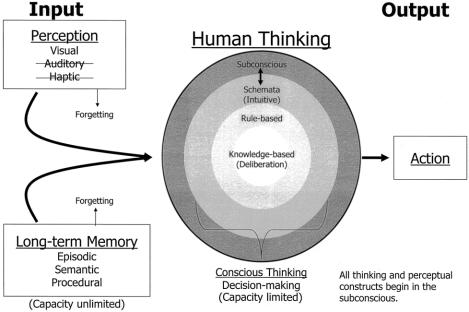Figure 5. Conceptual model of human cognition (adapted from references 5, 20, 21). The decision-making part of the mind is depicted by the four concentric circles in the center. Conscious thought is represented by the innermost three circles, where decisions require varying levels of cognitive energy: schemata or intuitive decisions require the least resources. Accurate intuitive decision-making comes as a result of extensive experience and training. All expertise is largely intuitive. Uneducated intuitive decisions, however, have a low accuracy level. Rule-based thinking invokes learned responses that might not have become intuitive: “turn the wheels in the direction of the skid” is an example. Knowledge-based thinking requires the greatest amount of attention and deliberation (for example, complex decisions involving large amounts of data; creative thinking; etc.). Everything that reaches the conscious mind is first processed in the subconscious, which filters the virtually limitless number of possible thoughts and allows a select few to reach consciousness. Even perceptual information is highly filtered. We are consciously aware at any moment of only a small portion of the images, sounds, tactile and proprioceptive stimuli, and smells that are reaching us. We can selectively focus attention from one to another but not to more than a few at a time. It is impossible, for example, to follow two busy independent audible conversations simultaneously. Perception of events in the operating field might include visual, haptic (see text), or auditory information. Laparoscopic surgery eliminates the very useful haptic input and stereoscopic depth perception. Guidance for the operation relies almost entirely on visual data, so imaging equipment should be of the highest quality.

An official website of the United States government
Here's how you know
Official websites use .gov
A
.gov website belongs to an official
government organization in the United States.
Secure .gov websites use HTTPS
A lock (
) or https:// means you've safely
connected to the .gov website. Share sensitive
information only on official, secure websites.
